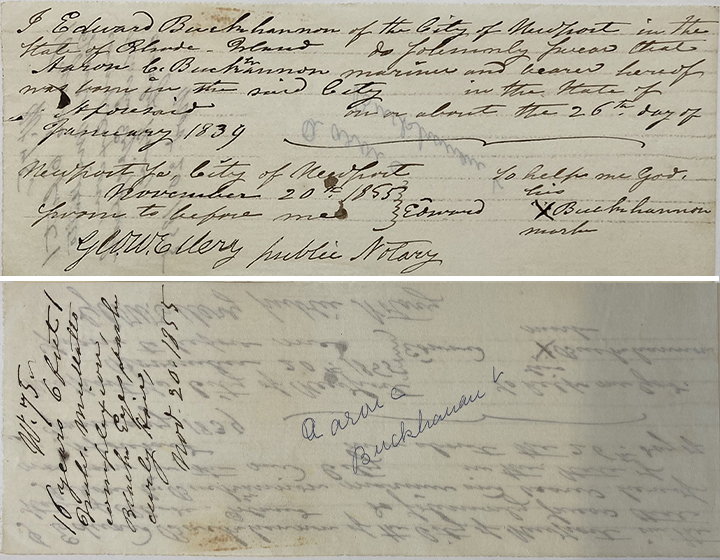This is a guest blog post by Maureen Iplenski, MA/PhD in History, American Studies, Certificate in Museum Studies (expected 2026) University of Delaware. Maureen is a 2022 Buchanan Burnham Fellow, contributing towards the “BIPOC Biographies from the Archives of the Newport Historical Society” initiative.
In 1914, Aaron C. Buchanan was celebrated as one “of the best known colored citizens in Newport.”[1] His accolades as a Captain of the Burnside Guards, an African American brigade organized during the Civil War, along with his work as an expressman, a teamster, and in his later life, a factory worker, likely earned him this reputation.[2] He was also quite active within his community. According to the Newport Daily News, Aaron acted as a Secretary for the Stone Mill Masonic Lodge.[3] Prior to these roles, at just sixteen years old, Aaron labored as a cabin boy on Newport’s merchant ships.
A record of Aaron’s early life was recently identified within the Newport Historical Society’s Custom House Records. On a small slip of paper, Aaron’s date and place of birth was inscribed. He was born in Newport, Rhode Island on January 26, 1839. On the reverse of this paper, is a brief physical description of the young Aaron: “16 years, 6 feet 1 inches, mulatto complexion, black eyes, dark curly hair.” The term “mulatto” was employed throughout the 19th century to describe a person of mixed African and European heritage. These slips, otherwise known as certificates of birth, were held by all mariners. They validated a person’s identity and offered some protection to sailors who faced impressment. Aaron’s certificate was endorsed by Public Notary George Ellery on November 20th, 1855 – and signed by Aaron’s father, Edward Buchanan, who testified to the birth of his son.

Certificate of Birth Aaron Buchanan (1855), showing Aaron’s age and his physical description. NHS Custom House Records, Box B1, Folder 2, Collection of the Newport Historical Society.
By becoming a mariner, Aaron was certainly following in the footsteps of his father. Edward, who was born in Mauritius, worked as a steward on a number of ships, including the ‘Niagara’ which sailed from Massachusetts to Havana, and the ship called ‘Java,’ which sailed to the East Indies.
Throughout Aaron’s 10 years at sea, he was a cabin boy on the brig “Mechanic,” and worked as a sailor. As a cabin boy, he completed much of the domestic duties on board. Working on these ships in the years leading up to the Civil War, Aaron likely interacted with those who enslaved African Americans. In fact, George Ellery, the notary who signed Aaron’s certificate of birth, enslaved — or at the very least, indentured — an African American woman. According to the 1820 Census, a “Free Black” woman resided in the Ellery Household. Considering her “free status”, and that she was no longer listed in the 1830 Census, it is probable that she was enslaved for a specified term. The Rhode Island Gradual Abolition Law of 1784 required those who were born from an enslaved individual after March 1, 1784, to be manumitted once they reached the age of 21. Due to this impending manumission, these individuals were deemed “free” despite being bound to a household. The African American woman in Ellery’s Household, therefore, may have completed her required term.
Due to this Gradual Abolition Law, the presence of slavery in Rhode Island was relatively minimal by the 1840s. [4] Aaron, however, may have witnessed the practice of slavery throughout his journeys at sea. Newport ships often sailed to the Southern States, where slavery remained legal, to trade goods. For instance, the Hazard Family in Newport produced a coarse wool-and-cotton blended cloth, termed “Negro cloth,” until the mid-1850s. The cloth was then transported to the Southern States, where it was used to clothe enslaved African Americans. It is not known how Aaron specifically came in contact with the institution of slavery, however, it is known that he directly supported the Union’s efforts to abolish slavery as a Captain of the Burnside National Guards. [5]
In 1869, shortly after his service, Aaron married Margaret Buchanan. The couple had six children: Edith, Clarence, Aaron, Vernon, Frederick, and Edward. Aaron and Margaret, along with a number of their children, are buried in God’s Little Acre, which is located in Newport’s Common Burial Ground.
The simple descriptions scribbled on sailors’ identification cards provide just a quick snapshot of a person’s life. In Aaron’s case, however, we can see that this snapshot can lead to a fuller picture. Along with being a sailor, Aaron was a Veteran of the Civil War, a community leader, a father, a husband, and a friend. Aaron represents the possibilities of piecing together the lived experiences of African Americans in 19th century Newport. He also demonstrates the difficult position of Free Black men in 19th century Rhode Island as he witnessed the harms of enslavement, while also enjoying the opportunities of freedom.
[1] Newport Daily News, “On the Death Record,” December 12, 1914.
[2] The Newport Daily News, “On the Death Record: Aaron C. Buchanan, One of the Best Known Colored Citizens of Newport,” December 12, 1914, shares his position as Captain for the Burnside Guards. His other roles are shared through Census Records from 1850-1910.
[3] Newport Daily News, “Stone Mill Lodge Officers Installed,” December 16, 1902.
[4] “Slave Population of the United States” in Statistics of the United States. https://www2.census.gov/library/publications/decennial/1850/1850c/1850c-04.pdf
[5] “1890 Veteran’s Schedules of the U.S. Federal Census” 1890. Accessed on Ancestry.com. https://www.ancestrylibrary.com/imageviewer/collections/8667/images/RIM123_92-0121?treeid=&personid=&hintid=&queryId=3166a0973edb4e3c6b94ffa4f55d36d0&usePUB=true&_phsrc=sAL63&_phstart=successSource&usePUBJs=true&_gl=1*1mm66s9*_ga*MTIwOTM2MDA2NC4xNjQ3NTMzNzEy*_ga_4QT8FMEX30*MTY1NjQzOTIwNi45LjEuMTY1NjQzOTIyMC40Ng..&pId=835392